Ethnic Identity, Group Status and Type of Settlement as Predictors of Ethnic Intolerance
Abstract
The results of the field research of intergroup attitudes in Southern Russia (N=723) demonstrated that the relationships of the valence and uncertainty of ethnic identity, perceived discrimination and the level of religious identity with intergroup attitudes depend on a group status (majority-minority) and the type of settlement (dense - sparse). The perceived discrimination predicts the intolerance of intergroup attitudes among the majority group members whereas, the valence and uncertainty of ethnic identity - among the minorities members. The salience of ethnic identity and high level of religious identity predict intolerant attitudes among migrants with the dense way of settlement, the valence of identity and perceived discrimination predict intolerant attitudes among the migrants with the sparse type of settlement. The willingness to distinguish between people by religion provides the maintenance of their group boundaries and identity in multicultural regions of Russia. The growth of uncertainty of ethnic identity, decrease of perceived discrimination and the level of religious identity as well as general ethnic tolerance provide better adaptation of migrants in multicultural regions of Russia.
Themes: Social psychology
Pages: 102-119
DOI: 10.11621/pir.2008.0007
Keywords: Social Psychology, Ethnic Identity
Introduction
As we demonstrated in our previous researches such socio-psychological factors as the valence and salience of one's own ethnic identity, perceived discrimination and the level of religious identity predicted intolerant intergroup attitudes among members of different ethnic groups in Russia's multicultural regions. Specifically, positive ethnic identity was related positively, whereas negative one was related negatively with the tolerant intergroup attitudes. The uncertainty (or ambivalence) of ethnic identity, perceived discrimination and the high level of religious identity were related positively with ethnic intolerance (Lebedeva & Tatarko, 2003, 2004).
We consider the valence of ethnic identity as a continuum between positive and negative attitudes toward one's own ethnicity. The positivity-negativity of ethnic autostereotypes and of the feelings associated with one's own ethnicity served as empirical indicators of this construct (Lebedeva, 1999). The meaning of this construct is very close to "confidence in one's own identity" which according to famous multicultural assumption is a basis for tolerance (Berry, 1984, Berry & Kalin, 2000).
The concept of "salience-uncertainty (or ambivalence) of group identity" has different meanings in different researches (Miller & Brewer, 1984; Gaertner, 1994; Brown, 2000; Taylor, 2002). In our previous research, the ambivalence of group identity was operationalized in terms of the feeling to be closer to other groups than to one's own group (Lebedeva & Tatarko, 2003, 2004). Consequently, the salience of group identity corresponds to the feeling of being closer to in-group than to out-groups. Previous studies revealed that the high salience of ethnic identity and distinctiveness of group boundaries relate negatively to intergroup outcomes (Brewer & Miller, 1984; Gaertner et al., 1993; Lebedeva, 1999). In our research the high subjective salience of ethnic identity was associated with positive whereas the subjective ambivalence was associated with negative intergroup attitudes (Lebedeva & Tatarko, 2003, 2004). A possible explanation of these results is that in an unstable society ethnic (cultural, religious) self-identification may reduce general uncertainty and serve as a tool for the process of self-awareness and self- definition.
According to Brown (2000), changing the salience of group identities in contact situations offers the promise of achieving generalized attitude change. Three different strategies exist in this case: decategorization, in which all group identities are de-emphasized, re-categorization in which a superordinate identity become salient, thus subsuming problematic subgroup divisions, and categorization in which cooperation is established while retaining the distinctive identity of participating groups. Rupert Brown wrote that there may be some virtue in keeping the group identity at least minimally salient while simultaneously optimizing the various conditions for successful contact (Brown, 2000, p. 351). In some ways this seems a somewhat paradoxical strategy. In order to reduce prejudice towards an outgroup, we are suggesting that maintaining the psychological salience of an intergroup distinction can be advantageous (Miller & Brewer, 1984; Wilder, 1984; Scaberry et al., 1997; Desforges, 1991; Gaertner, 1994; Brown, 2000).
The problem of identity security is close to the threat for identity. Integrated threat theory asserts that four types of threat can lead to prejudice: realistic threat, symbolic threat, intergroup anxiety, negative stereotypes (Stephan & Stephan, 2000). Outgroups are disliked if they are perceived to pose realistic or value threats to the ingroup, if ingroup members are anxious about interacting with the outgroup because they expect negative outcomes from such interactions, or if negative stereotypes of outgroups are threatening. It is important to note that perceived threats are often unrealistic or exaggerated (Stephan & Stephan, 2001).
In order to understand the specifics of intergroup interactions in multicultural regions, we need to examine a higher unit of analysis, namely a social system. If we look at these regions as social systems where every ethnic group is an element of a bigger whole, we can understand the aim of the differentiation and integration processes. Multicultural regions with a long history of ethnic group coexistence can be viewed as balanced social systems, where the processes of integration prevail over the processes of differentiation. The regions, where multicultural characteristics become the consequence of contemporary migration of culturally-distant groups, present a non-balanced system with the high levels of differentiation of the comprising groups. The aim of such differentiation processes may be not the separation of social (ethnic) groups, but the development of effective group boundaries, which in turn enable people to maintain ethnic group distinctiveness needed for positive group self-identity and ethnic tolerance.
All these abovementioned factors (the valence and salience of ethnic identity, perceived discrimination and the level of religious identity), we defined as "internal" (socio-psychological) factors, which predict intergroup attitudes. But in reality, there are many, so called "external" factors, which can change the influence of these "internal" factors.
In 2006-2007 we conducted studies in three multicultural regions of Russia (Rostov, Krasnodar and Stavropol Provinces in the Southern Russia).
The objective of this research was to discover relations between identity, perceived discrimination, the level of religious identity and in-group and out-group attitudes moderated by group status and the type of settlement.
The following hypotheses were tested:
- The prediction of intergroup attitudes by the valence and salience of ethnic identity, perceived discrimination and the level of religious identity will be moderated by the status of a group and the type of settlement.
- Intolerant intergroup attitudes among majority members will be mostly predicted by perceived discrimination, whereas intolerant intergroup attitudes among minorities' members will be mostly predicted by the valence and salience of their ethnic identity.
- The salience of ethnic identity and the level of religious identity will predict intolerant attitudes among members of the groups with dense population, whereas the valence of ethnic identity and perceived discrimination will predict intolerance among members of the groups with the sparse way of settlement.
Method
Residents (N=917) of Rostov, Krasnodar and Stavropol Provinces of the South Russia participated in our survey. The ethnic composition of our sample is shown in Table 1. The respondents' age ranged from 22 to 63 years, and their education ranged from secondary-school to higher-school levels. The survey was conducted in 2002.
Measures and Procedures
The respondents were asked to complete a questionnaire containing the scales developed for this research together with the modified versions of some well-established techniques.
Table1
Description of the Samples
|
Region |
Ethnic Group |
Number of Respondents |
Regional N |
|
Rostov Province (RP) |
Cossacks |
144 |
451 |
|
Russians |
127 | ||
|
Meskhetians (Turks) |
75 | ||
|
Chechens |
35 | ||
|
Armenians |
40 | ||
|
Ukrainians |
30 | ||
|
Krasnodar Province (KP) |
Cossacks |
50 |
200 |
|
Russians |
50 | ||
|
Meskhetians (Turks) |
50 | ||
|
Kurds |
50 | ||
|
Stavropol Province (SP) |
Russians |
100 |
266 |
|
Chechens |
31 | ||
|
Armenians |
54 | ||
|
Dagestans |
42 | ||
|
Greeks |
39 | ||
|
|
Total |
|
N=917 |
- The valence of ethnic identity scale assessed the feelings associated with one's own ethnic belonging using a 5-point scale from J (feeling humiliated) to 5 (feeling pride).
- The salience (uncertainty) of ethnic identity was measured by the statement, "I feel that I am closer to and understand better the people of a different ethnic group than those of my own one". To answer this question they used a 5-point scale ranged from 1 (disagree) to 5 (agree).
- Intergroup attitudes were assessed by three indicators.
- The respondents' general ethnic intolerance was evaluated using a following statement, "To tell the truth, I would prefer not to have contacts with the members of certain ethnic groups". The response options were evaluated by 5-point rating scale from 1 (I totally disagree) to 5 (I fully agree);
- The willingness to distinguish between people according to religion was evaluated by the agreement with the statements such as, "If people confess the same religion, it is easier for them to understand each other".
c) The willingness to distinguish between people according to ethnicity
was evaluated the agreement with the statements such as "When meeting a person, I pay attention to his/her nationality (ethnicity)". The higher scores reflect the greater willingness to distinguish. In the last two cases a 5-point scale was used.
- The level of perceived discrimination was measured by the agreement (from 1 totally disagree to 5 (fully agree) with a statement, "I feel stung to the quick when I hear someone say something insulting about my ethnic group".
- The level of religious identity was assessed using a question, "How religious are you?" The response options ranged from 1 (not at all) to 5 (very religious).
Method of Analysis
A standard multiple regression analysis was used to determine whether indices of ethnic intolerance were predicted by ethnic identity, the level of perceived discrimination and the level of religious identity.
The data obtained using the modified Semantic Differential method was processed using the principal components factor analysis, followed by a Varimax rotation. The concepts evaluated by the respondents were placed in the space of the two factors extracted by the factor analysis. This valuation was based on the calculation of factor weights of the objects of scaling. The statistical packages Statistica 5.1 and SPSS 11.0 were employed to process the data.
Results
The relationship of "internal" factors with intergroup attitudes (overall sample)
Table 2
Prediction by Four "Internal" Variables of Intergroup Attitudes (N=917)
|
Outcome Variabless |
Predictor Variables |
R2 |
F | |||
|
Valence P |
Uncertainty (3 |
Perceived Discrimination (3 |
Religious Identity |
|
| |
|
General ethnic intolerance |
-008 |
27*** |
,10* |
,10** |
,10 |
18,8*** |
|
Distinguishing by religion |
-019 |
,09* |
1^*** |
,10** |
,05 |
g g*** |
|
Distinguishing by ethnicity |
-10* |
j 5*** |
,10** |
15*** |
,05 |
10,8*** |
*p<0,05; **p<0,01; ***p<0,001
We can see that all the four so called "internal" factors predict intergroup attitudes among all our respondents. The uncertainty of ethnic identity, the level of religious identity and perceived discrimination positively were related with intolerant intergroup attitudes. The Positive valence of ethnic identity was negatively related with the willingness to be distinguished by ethnicity.
2. The role of a group status and the type of settlement in intergroup attitudes
The research question for this part of the study was the following: how can the revealed relationship between abovementioned "internal" (socio-psychological) factors change under the different "external" conditions -group status (majority - minority) and the type of settlement (dense or sparse)?
a) The role of the group status
We hypothesized that intolerant intergroup attitudes among majority will be predicted mostly by perceived discrimination (according The Integrated Threat Theory of Prejudice of C. & W. Stephan); and among minorities - by the valence and salience of ethnic identity (according to Multicultural Assumption) as well as by the perceived discrimination.
Table3
Means, Standard Deviations and Differences Between Majority and Minority Groups in Intergroup Attitude Measures
|
Variables |
Majority Group (Russians, 3 groups, N=277) |
Minority Groups (10 groups, N=446) | ||
|
M |
a |
M |
о | |
|
Valence of ethnic identity |
3,6* |
1.5 |
s3,8* |
1.5 |
|
Uncertainty of ethnic identity |
1,8 |
1.6 |
2,1 |
1,3 |
|
Perceived discrimination |
2,0* |
U |
2,4* |
1.3 |
|
General ethnic intolerance |
2 \*** |
1,3 |
2 J*** |
1.4 |
|
Distinguishing by ethnicity |
3,8*** |
1.4 |
2,6*** |
1.5 |
|
Distinguishing by religion |
4,2* |
1.2 |
3,9* |
1.3 |
|
The level of religious identity |
|
0.95 |
3,5** |
1,4 |
*p<0,05; **/><0,01; ***p<0,001
From the table 3 one can see that the positive valence of ethnic identity, the level of religious identity and perceived discrimination of minority group's members are higher while general ethnic intolerance and willingness to distinguish between people by religion and ethnicity are lower in comparison to the members of the majority group.
We can see that the most strong predictor of the ethnic intolerance among majority members (Russians) is the level of perceived discrimination, the uncertainty of identity predicts ethnic intolerance but Russians mostly have the salient ethnic identity, it's salience relates with general ethnic tolerance. The level of religious identity (low in comparison with the ethnic minorities) also predict the willingness to distinguish among people by religion and ethnicity.
The results show that general ethnic intolerance among minorities is predicted mostly by the characteristics of their ethnic identity (valence and uncertainty). The positive valence of their identity is high and serves as the mechanism of psychological protection, because it is closely related with ethnic intolerance. Their ethnic identity is more uncertain in comparison to majority members, but it may be regarded as rather salient, so it is salience that is related to their general ethnic tolerance.
Table 4
Prediction by Four "Internal" Variables of Intergroup Attitudes in a Majority Group (N= 278)
|
Outcome Variables |
Predictor Variables |
R2 |
F | |||
|
Valence P |
Uncertainty P |
Perceived Discrimination p |
Religious Identity | |||
|
General ethnic intolerance |
|
,17** |
|
|
,03 |
7,5** |
|
Distinguishing by religion |
|
|
,20*** |
,15* |
,07 |
9 I*** |
|
Distinguishing by ethnicity |
|
|
,16** |
,12* |
,04 |
5,6** |
V<0,05; **p<0,01; ***/7<0,001
Table 5
Prediction by Four "Internal" Variables of Intergroup Attitudes in Minorities (N= 409)
|
Outcomes |
Predictors |
R2 |
F | |||
|
Valence P |
Uncertainty p |
Perceived Discrimination P |
Religious Identity | |||
|
General ethnic intolerance |
,11* |
,12* |
|
|
,03 |
5,2** |
|
Distinguishing by religion |
|
|
,11* |
,12* |
,02 |
5,0* |
|
Distinguishing by ethnicity |
|
|
-12 |
-10* |
,02 |
5,6* |
V<0,05; **p<0,01; ***/?<0,001
The perceived discrimination and the level of religious identity are positively related with the willingness to distinguish by religion and negatively - with the willingness to distinguish by ethnicity.
b) The role of the type of settlement
To investigate the role of the type of settlement, we compare two migrant groups: Chechens and Turks-Meschetians, which used to settle differently (dense or sparse). We surveyed four different samples: 2 samples of Chechens from Stavropol and Rostov provinces and 2 samples of Turks-Meschetians from Krasnodar and Rostov provinces.
Table 6
Means, Standard Deviations and Differences Between Groups with dense and sparse ways of settlement in Intergroup Attitude Measures
|
Variables |
Chechens |
Turks-Meschetians | ||||||
|
Dense type of settlement N=35 |
Sparse type of settlement N=31 |
Cocentrated type of settlement N=50 |
Disperse type of settlement N=75 | |||||
|
|
M |
a |
M |
о |
M |
о |
M |
О |
|
Valence of ethnic identity. |
2 2*** |
1,7 |
4 g*** |
,72 |
2,1* |
1,5 |
2,4* |
1,8 |
|
Uncertainty of ethnic identity |
1 4** |
0,9 |
7 9** |
,87 |
2,5 |
1,4 |
2,7 |
1,5 |
|
Perceived discrimination |
4,3 |
14 |
4,5 |
1,2 |
|
1,6 |
|
1,4 |
|
General ethnic intolerance |
|
1,1 |
2 7*** |
1,3 |
1,7 |
1,3 |
2,0 |
1,5 |
|
Distinguishing by ethnicity |
|
1,5 |
|
1,4 |
2,4 |
1,7 |
2,7 |
1,7 |
|
Distinguishing by religion |
4,2 |
1,4 |
4,.0 |
1,2 |
4,6 |
1,3 |
4,3 |
1,5 |
|
The level of religious identity |
4,2 |
,51 |
1,8 |
,63 |
4 g*** |
,90 |
7 g*** |
,50 |
We can see that the migrants settled in a sparse way have higher level of positivity and uncertainty of their ethnic identity, perceived discrimination and religious identity, general ethnic intolerance and the willingness to distinguish among people by ethnicity in comparison to the migrants settled in a dense way.
Let's compare the differences in predicting ethnic intolerance in two groups which differ by the type of their settlement.
We can see that the uncertainty of ethnic identity predicted positively general ethnic intolerance and negatively - the willingness to distinguish by religion. We hypothesize that because of dense way of living they have salient ethnic identity what means that this salience predicts general ethnic tolerance and the willingness to distinguishing by religion. High level of their religious identity predicts their willingness to distinguishing among people by ethnicity.
Table 7
Prediction by Four "Internal" Variables of Intergroup Attitudes in Migrant Groups with dense way of settlement (N=85)
|
Outcomes |
Predictors |
R2 |
F | |||
|
Valence (3 |
Uncertainty P |
Perceived Discrimination P |
Religious Identity P |
|
| |
|
General ethnic intolerance |
|
42*** |
|
|
,12 |
|
|
Distinguishing by religion |
|
-33** |
|
|
,11 |
9,6** |
|
Distinguishing by ethnicity |
|
|
|
.24* |
,06 |
4,7* |
V<0,05; **p<0,01; ***p<0,001
Table 8
Prediction by Four "Internal" Variables of Intergroup Attitudes in Migrant Groups with sparse way of settlement (N= 106)
|
Outcomes |
Predictors |
R2 |
F | |||
|
Valence P |
Uncertainty P |
Perceived Discrimination P |
Religious Identity | |||
|
General ethnic intolerance |
3 [ ** |
|
_ 79** |
|
,15 |
g 4*** |
|
Distinguishing by religion |
|
|
27** |
|
,07 |
7j** |
V><0,05; **p<0,01; ***p<0,001
The positive valence of the ethnic identity predicts general intolerance among the migrants with the sparse type of settlement, while the perceived discrimination predicts negatively general ethnic intolerance what means that the high level of perceived discrimination predicts their ethnic tolerance (willingness to be socially included). Perceived discrimination positively predicts the willingness to distinguish among people by religion, because under the sparse way of settlement the migrants don't strive to demonstrate their ethnicity and their religious identity maintains their group boundaries and identity.
Discussion
As the results of our research demonstrated that such "internal" factors as the valence and salience of ethnic identity, perceived discrimination and the level of religious identity predict intolerant intergroup attitudes in the multicultural regions of Southern Russia. The overall model of the relationship of these predictors with intergroup attitudes is presented at the Figure I.
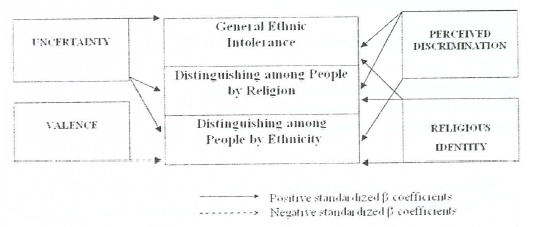
Figure 1. Model of Social-Psychological Factors of Ethnic Intolerance in the Multicultural Regions of Southern Russia.
But the degree of the influence of each "internal" factor depends on "external" conditions, such as group status and the type of settlement of the group.
a)The influence of the group status
According to the research data, the influence of "internal" factors on intergroup attitudes depends on the status of the groups: majority vs. minority. The intolerant intergroup attitudes of the majority group are predicted by perceived discrimination, and, in a less degree, by the level of their religious identity, which was low in comparison to the minorities.
The intolerant intergroup attitudes of the members of the minority groups are mostly related with the characteristics of their ethnic identity (valence and salience).
The members of the minority groups don't strive to distinguish among people by their ethnicity and their ethnicity doesn't serve as an indicator of their group boundaries and in-group identity. It is more uncertain then those of the majority. The level of the religious identity becomes such criteria of the minority groups' boundaries and identity maintenance which is very high.
The model showing the differences in the predictors influence on intergroup attitudes is presented on the figure 2.
b) The influence of the Type of Settlement
According to our data, the salience of ethnic identity of the migrants resided by a dense way (as ethnocultural enclaves) predicts their general ethnic tolerance and the willingness to distinguish among the people by religion, and the high level of religious identity which in its turn predicts the willingness to distinguish among people by ethnicity.
The graphic representation of the psychosemantic spaces of the intergroup relations illustrates their way of adaptation in the multicultural regions of Southern Russia. These psychosemantic spaces of two different groups (Chechens and Turks-Meschetians) in two different regions (Stavropol and Krasnodar provinces) are almost identical (Fig. 3 and Fig. 4).
The ethnic pictures of the world of such groups clearly demonstrates the tendency of the maintenance of the group boundaries and identity and their adaptation and interaction is mostly on an intergroup level in the form of group hierarchy.
According to our data, the positive ethnic identity and low level of perceived discrimination among migrants with the sparse type of settlement predict their general ethnic intolerance, and the high level of perceived discrimination predicts the willingness to distinguish among people by religion.

Figure 2. The Model of the Relationships among Intergroup Attitudes and "Internal "Factors in Majority and Minority Groups.
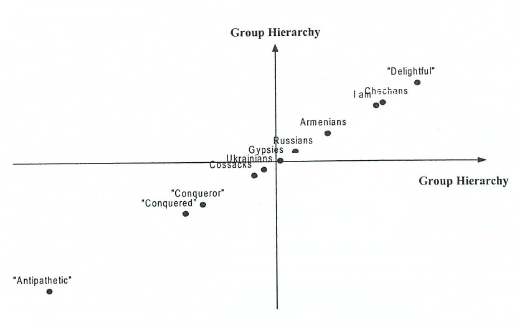
Figure 3. Graphic representation of modalities on the two factor axes on the evaluation of different groups by Chechens (Rostov Province)
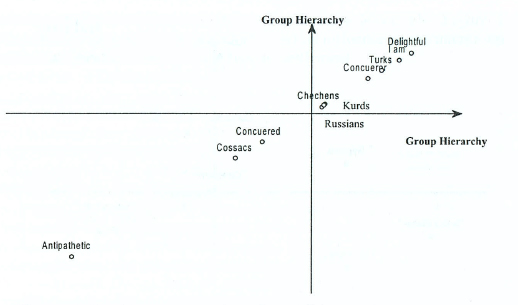
Figure 4. Graphic representation of modalities on the two factor axes on the evaluation of different groups by Turks-Meskhetians (Krasnodar Province)
These results may be explained the integrated threat theory of prejudice: the symbolic threat to their cultural identity from the dominant society provokes them to conceal one's ethnic identity with the aim of social inclusion and to maintain their group identity based on intra-cultural (religious) criteria.
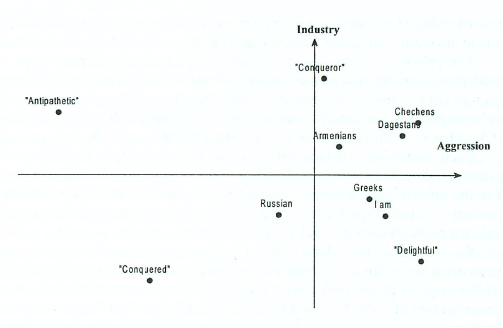
Figure 5. Graphic representation of modalities on the two factor axes on the evaluation of different groups by Chechens (Stavropol Province)
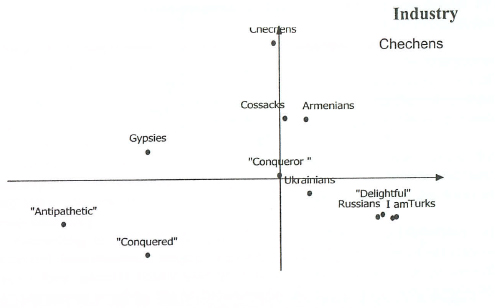
Figure 6. Graphic representation of modalities on the two factor axes on the evaluation of different groups by Turk-Meskhetians (Stavropol Province)
The psychosemantic spaces of the groups with the disperse type of settlement are very similar too despite different ethnic identity and different regions (Fig. 5 and 6). We can see clearly that the members of such groups strive to identify themselves with another ethnic groups, then their own ones (Chenchens - with Greeks, and Turks-Meskhetians - with Russians).
Such uncertainty of their ethnic identity enables them to achieve it's positive valence and successfully adapt in the region on the individual level. But the price of such adaptation is very high - the lost of their own cultural identity - what Rupert Brown called "de-categorization". This positive valence predicts their general ethnic intolerance.
So, the group boundaries of the migrant groups with dense way of settlement are maintain by their ethnic identity, while the group boundaries of the migrant group with sparse way of settlement are maintain by their religious identity which consist with the hypothesis of Hantington about the growing role of religion as the criteria of group identification in the future. The dense way of settlement displace the conflict into personality level. The Figure 7 demonstrates the specifics of the internal factors influence on the intergroup attitudes in the dependence of the type of settlement.
Figure 7. The model of the relationship between the 'Internal" factors and intergroup attitudes in the groups with the dense and sparse ways of settlement.
Conclusion
- The relationships of the valence and uncertainty of ethnic identity, perceived discrimination and the level of religious identity with intergroup attitudes depend on a group status (majority-minority) and the type of settlement (concentrated - disperse).
- The perceived discrimination predicts the intolerance of intergroup attitudes among the majority group members whereas, the valence and uncertainty of ethnic identity - among the minorities members.
- The salience of ethnic identity and high level of religious identity predict intolerant attitudes among migrants with the dense way of settlement, the valence of identity and perceived discrimination predict intolerant attitudes among the migrants with the sparse type of settlement.
- The willingness to distinguish between people by religion provides the maintenance of their group boundaries and identity in multicultural regions of Southern Russia.
The growth of uncertainty of ethnic identity, decrease of perceived discrimination and the level of religious identity as well as general ethnic tolerance provide better adaptation of migrants in multicultural regions of Southern Russia.
References
Berry, J.W., Sam, D. Acculturation and adaptation // Handbook of Cross-Cultural Psychology. Vol. 3. Social behaviour and applications / Eb. by. J.W. Berry, M.H. Segall, Kagitcbasi. Boston: Allyn & Bacon, 1997. P. 291-326.
Brown, R. Group processes. Dynamics within and between groups. Blackwell Publishers, 2000.
Desforges, D.M., Lord, C.G., Ramsey, S.L. Mason, J.A., Van Leeuwen, M.D., West, S.C. and Lepper, M.R. (1991). Effects of structured cooperative contact on changing negative attitudes towards stigmatized groups, Journal of Personality and Social Psychology, 60, 531-44.
Gaertner, S.L., Rust, M., Dovidio, J.F., Bachman, B. and Anastasio, P. The contact hypothesis: the role of a common ingroup identity on reducing intergroup bias / Small Group Research. 1994. Vol. 25. P. 224-249.
Lebedeva, N.M. (1999). Coping with the "Syndrome of Imposed Ethnicity" among Ethnic Russians. In W. Lonner et al. (Eds.) Merging Past, Present, and Future: Selected Proceedings of the 15th International Congress of the International Associations for Cross-Cultural Psychology. Swets & Zeitlinger Publ, Lisse. P. 266-282.
Lebedeva, N.M. (2000). Changing social and ethnic identity in post-soviet states: common frameworks and trends. - Paper, presented at the International Congress of the International Associations for Cross-Cultural Psychology, Pultusk, Poland, 2000.
Lebedeva, N.M., Malkhozova, F.M. (2002). Socio-psychological research of ethnic tolerance in Karachaevo-Cherkessiya. In N. Lebedeva (Ed.), Identity and Tolerance (P. 152-168). IEA RAS. (in Russian).
Lebedeva, N., Tatarko, A. Socio-Psychological Factors of Ethnic Intolerance in Russia's Multicultural Regions // in B. Setiadi at al. Ongoing Themes in Psychology and Culture / IACCP Press, 2004. P. 507-533.
Lebedeva, N., Tatarko, A. Socio-psychological Factors of Ethnic Tolerance and The Strategies of Intergroup Intreaction in Multicultural Regions of Russia // Psychological Journal. 2003. 24 (5). P. 31-44. (in Russian).
Leong, C.-H., Ward, C, (2000). Identity conflict in sojourners. International Journal of Intercultural Relations, 24, 763-776.
Mainous, A.G. (1989). Self-concept as an indicator of acculturation in Mexican Americans, Hispanic Journal of Behavioral Sciences, 11, 178-189.
Miller, N. and Brever, M.B. (eds). (1984). Groups in Contact: The psychology of Desegregation. NY: Academic Press.
Taylor, D. The Quest for Identity. From minority groups to Generation Xers. Praeger, 2002.
Wilder, D.A. (1984). Intergroup contact: the typical member and the exception to the rule. Journal of Experimental Social Psychology, 20,177-94.
Scaberry, N.C., Ratcliff, CD., Lord, C.G., Lanicek, D.L. and Desforges, D.M. (1977). Effects of individuating information on the generalization part Allport's Contact Hypothesis. Personality and social Psychology Bulleten, 23, 1291-9.
Note
[1] The research has been supported by The Scientific Foundation of HSE (N 08-04-0007) and Russian Scientific Foundation (N 08-06-00702a).
To cite this article: Lebedeva, Nadezhda M., Tatarko, Alexander N. (2008). Ethnic Identity, Group Status and Type of Settlement as Predictors of Ethnic Intolerance. Psychology in Russia: State of the Art, 1, 102-119
The journal content is licensed with CC BY-NC “Attribution-NonCommercial” Creative Commons license.










